Yanwei Pang
SNNSIR: A Simple Spiking Neural Network for Stereo Image Restoration
Aug 17, 2025Abstract:Spiking Neural Networks (SNNs), characterized by discrete binary activations, offer high computational efficiency and low energy consumption, making them well-suited for computation-intensive tasks such as stereo image restoration. In this work, we propose SNNSIR, a simple yet effective Spiking Neural Network for Stereo Image Restoration, specifically designed under the spike-driven paradigm where neurons transmit information through sparse, event-based binary spikes. In contrast to existing hybrid SNN-ANN models that still rely on operations such as floating-point matrix division or exponentiation, which are incompatible with the binary and event-driven nature of SNNs, our proposed SNNSIR adopts a fully spike-driven architecture to achieve low-power and hardware-friendly computation. To address the expressiveness limitations of binary spiking neurons, we first introduce a lightweight Spike Residual Basic Block (SRBB) to enhance information flow via spike-compatible residual learning. Building on this, the Spike Stereo Convolutional Modulation (SSCM) module introduces simplified nonlinearity through element-wise multiplication and highlights noise-sensitive regions via cross-view-aware modulation. Complementing this, the Spike Stereo Cross-Attention (SSCA) module further improves stereo correspondence by enabling efficient bidirectional feature interaction across views within a spike-compatible framework. Extensive experiments on diverse stereo image restoration tasks, including rain streak removal, raindrop removal, low-light enhancement, and super-resolution demonstrate that our model achieves competitive restoration performance while significantly reducing computational overhead. These results highlight the potential for real-time, low-power stereo vision applications. The code will be available after the article is accepted.
Interpretable Few-Shot Image Classification via Prototypical Concept-Guided Mixture of LoRA Experts
Jun 05, 2025



Abstract:Self-Explainable Models (SEMs) rely on Prototypical Concept Learning (PCL) to enable their visual recognition processes more interpretable, but they often struggle in data-scarce settings where insufficient training samples lead to suboptimal performance.To address this limitation, we propose a Few-Shot Prototypical Concept Classification (FSPCC) framework that systematically mitigates two key challenges under low-data regimes: parametric imbalance and representation misalignment. Specifically, our approach leverages a Mixture of LoRA Experts (MoLE) for parameter-efficient adaptation, ensuring a balanced allocation of trainable parameters between the backbone and the PCL module.Meanwhile, cross-module concept guidance enforces tight alignment between the backbone's feature representations and the prototypical concept activation patterns.In addition, we incorporate a multi-level feature preservation strategy that fuses spatial and semantic cues across various layers, thereby enriching the learned representations and mitigating the challenges posed by limited data availability.Finally, to enhance interpretability and minimize concept overlap, we introduce a geometry-aware concept discrimination loss that enforces orthogonality among concepts, encouraging more disentangled and transparent decision boundaries.Experimental results on six popular benchmarks (CUB-200-2011, mini-ImageNet, CIFAR-FS, Stanford Cars, FGVC-Aircraft, and DTD) demonstrate that our approach consistently outperforms existing SEMs by a notable margin, with 4.2%-8.7% relative gains in 5-way 5-shot classification.These findings highlight the efficacy of coupling concept learning with few-shot adaptation to achieve both higher accuracy and clearer model interpretability, paving the way for more transparent visual recognition systems.
iEBAKER: Improved Remote Sensing Image-Text Retrieval Framework via Eliminate Before Align and Keyword Explicit Reasoning
Apr 08, 2025



Abstract:Recent studies focus on the Remote Sensing Image-Text Retrieval (RSITR), which aims at searching for the corresponding targets based on the given query. Among these efforts, the application of Foundation Models (FMs), such as CLIP, to the domain of remote sensing has yielded encouraging outcomes. However, existing FM based methodologies neglect the negative impact of weakly correlated sample pairs and fail to account for the key distinctions among remote sensing texts, leading to biased and superficial exploration of sample pairs. To address these challenges, we propose an approach named iEBAKER (an Improved Eliminate Before Align strategy with Keyword Explicit Reasoning framework) for RSITR. Specifically, we propose an innovative Eliminate Before Align (EBA) strategy to filter out the weakly correlated sample pairs, thereby mitigating their deviations from optimal embedding space during alignment.Further, two specific schemes are introduced from the perspective of whether local similarity and global similarity affect each other. On this basis, we introduce an alternative Sort After Reversed Retrieval (SAR) strategy, aims at optimizing the similarity matrix via reverse retrieval. Additionally, we incorporate a Keyword Explicit Reasoning (KER) module to facilitate the beneficial impact of subtle key concept distinctions. Without bells and whistles, our approach enables a direct transition from FM to RSITR task, eliminating the need for additional pretraining on remote sensing data. Extensive experiments conducted on three popular benchmark datasets demonstrate that our proposed iEBAKER method surpasses the state-of-the-art models while requiring less training data. Our source code will be released at https://github.com/zhangy0822/iEBAKER.
Optimal Transport Adapter Tuning for Bridging Modality Gaps in Few-Shot Remote Sensing Scene Classification
Mar 19, 2025



Abstract:Few-Shot Remote Sensing Scene Classification (FS-RSSC) presents the challenge of classifying remote sensing images with limited labeled samples. Existing methods typically emphasize single-modal feature learning, neglecting the potential benefits of optimizing multi-modal representations. To address this limitation, we propose a novel Optimal Transport Adapter Tuning (OTAT) framework aimed at constructing an ideal Platonic representational space through optimal transport (OT) theory. This framework seeks to harmonize rich visual information with less dense textual cues, enabling effective cross-modal information transfer and complementarity. Central to this approach is the Optimal Transport Adapter (OTA), which employs a cross-modal attention mechanism to enrich textual representations and facilitate subsequent better information interaction. By transforming the network optimization into an OT optimization problem, OTA establishes efficient pathways for balanced information exchange between modalities. Moreover, we introduce a sample-level Entropy-Aware Weighted (EAW) loss, which combines difficulty-weighted similarity scores with entropy-based regularization. This loss function provides finer control over the OT optimization process, enhancing its solvability and stability. Our framework offers a scalable and efficient solution for advancing multimodal learning in remote sensing applications. Extensive experiments on benchmark datasets demonstrate that OTAT achieves state-of-the-art performance in FS-RSSC, significantly improving the model performance and generalization.
Underlying Semantic Diffusion for Effective and Efficient In-Context Learning
Mar 06, 2025



Abstract:Diffusion models has emerged as a powerful framework for tasks like image controllable generation and dense prediction. However, existing models often struggle to capture underlying semantics (e.g., edges, textures, shapes) and effectively utilize in-context learning, limiting their contextual understanding and image generation quality. Additionally, high computational costs and slow inference speeds hinder their real-time applicability. To address these challenges, we propose Underlying Semantic Diffusion (US-Diffusion), an enhanced diffusion model that boosts underlying semantics learning, computational efficiency, and in-context learning capabilities on multi-task scenarios. We introduce Separate & Gather Adapter (SGA), which decouples input conditions for different tasks while sharing the architecture, enabling better in-context learning and generalization across diverse visual domains. We also present a Feedback-Aided Learning (FAL) framework, which leverages feedback signals to guide the model in capturing semantic details and dynamically adapting to task-specific contextual cues. Furthermore, we propose a plug-and-play Efficient Sampling Strategy (ESS) for dense sampling at time steps with high-noise levels, which aims at optimizing training and inference efficiency while maintaining strong in-context learning performance. Experimental results demonstrate that US-Diffusion outperforms the state-of-the-art method, achieving an average reduction of 7.47 in FID on Map2Image tasks and an average reduction of 0.026 in RMSE on Image2Map tasks, while achieving approximately 9.45 times faster inference speed. Our method also demonstrates superior training efficiency and in-context learning capabilities, excelling in new datasets and tasks, highlighting its robustness and adaptability across diverse visual domains.
CLIPer: Hierarchically Improving Spatial Representation of CLIP for Open-Vocabulary Semantic Segmentation
Nov 21, 2024



Abstract:Contrastive Language-Image Pre-training (CLIP) exhibits strong zero-shot classification ability on various image-level tasks, leading to the research to adapt CLIP for pixel-level open-vocabulary semantic segmentation without additional training. The key is to improve spatial representation of image-level CLIP, such as replacing self-attention map at last layer with self-self attention map or vision foundation model based attention map. In this paper, we present a novel hierarchical framework, named CLIPer, that hierarchically improves spatial representation of CLIP. The proposed CLIPer includes an early-layer fusion module and a fine-grained compensation module. We observe that, the embeddings and attention maps at early layers can preserve spatial structural information. Inspired by this, we design the early-layer fusion module to generate segmentation map with better spatial coherence. Afterwards, we employ a fine-grained compensation module to compensate the local details using the self-attention maps of diffusion model. We conduct the experiments on seven segmentation datasets. Our proposed CLIPer achieves the state-of-the-art performance on these datasets. For instance, using ViT-L, CLIPer has the mIoU of 69.8% and 43.3% on VOC and COCO Object, outperforming ProxyCLIP by 9.2% and 4.1% respectively.
Multi-Stage Knowledge Integration of Vision-Language Models for Continual Learning
Nov 11, 2024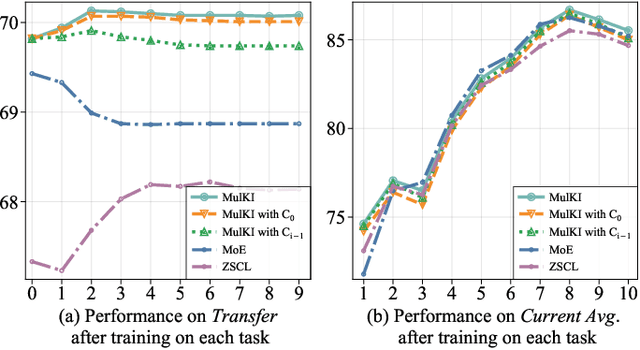

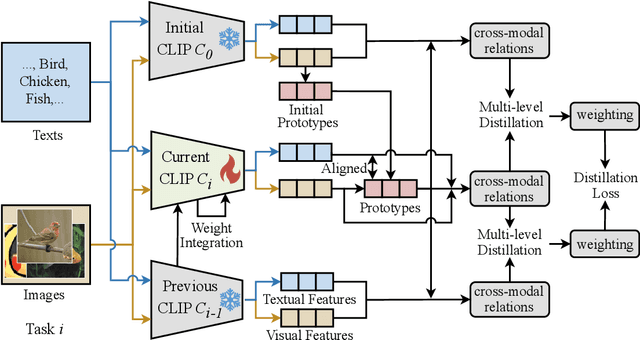
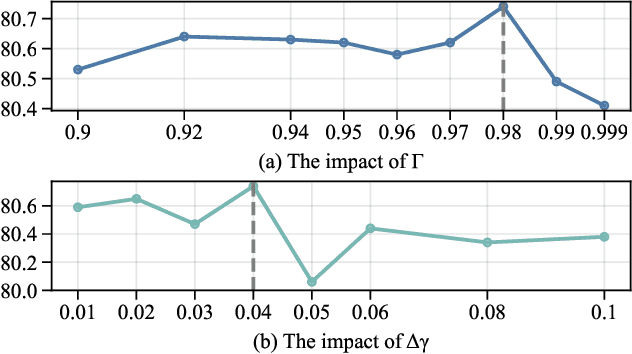
Abstract:Vision Language Models (VLMs), pre-trained on large-scale image-text datasets, enable zero-shot predictions for unseen data but may underperform on specific unseen tasks. Continual learning (CL) can help VLMs effectively adapt to new data distributions without joint training, but faces challenges of catastrophic forgetting and generalization forgetting. Although significant progress has been achieved by distillation-based methods, they exhibit two severe limitations. One is the popularly adopted single-teacher paradigm fails to impart comprehensive knowledge, The other is the existing methods inadequately leverage the multimodal information in the original training dataset, instead they rely on additional data for distillation, which increases computational and storage overhead. To mitigate both limitations, by drawing on Knowledge Integration Theory (KIT), we propose a Multi-Stage Knowledge Integration network (MulKI) to emulate the human learning process in distillation methods. MulKI achieves this through four stages, including Eliciting Ideas, Adding New Ideas, Distinguishing Ideas, and Making Connections. During the four stages, we first leverage prototypes to align across modalities, eliciting cross-modal knowledge, then adding new knowledge by constructing fine-grained intra- and inter-modality relationships with prototypes. After that, knowledge from two teacher models is adaptively distinguished and re-weighted. Finally, we connect between models from intra- and inter-task, integrating preceding and new knowledge. Our method demonstrates significant improvements in maintaining zero-shot capabilities while supporting continual learning across diverse downstream tasks, showcasing its potential in adapting VLMs to evolving data distributions.
A Fresh Look at Generalized Category Discovery through Non-negative Matrix Factorization
Oct 29, 2024
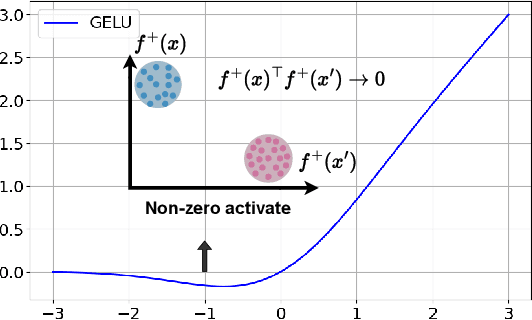


Abstract:Generalized Category Discovery (GCD) aims to classify both base and novel images using labeled base data. However, current approaches inadequately address the intrinsic optimization of the co-occurrence matrix $\bar{A}$ based on cosine similarity, failing to achieve zero base-novel regions and adequate sparsity in base and novel domains. To address these deficiencies, we propose a Non-Negative Generalized Category Discovery (NN-GCD) framework. It employs Symmetric Non-negative Matrix Factorization (SNMF) as a mathematical medium to prove the equivalence of optimal K-means with optimal SNMF, and the equivalence of SNMF solver with non-negative contrastive learning (NCL) optimization. Utilizing these theoretical equivalences, it reframes the optimization of $\bar{A}$ and K-means clustering as an NCL optimization problem. Moreover, to satisfy the non-negative constraints and make a GCD model converge to a near-optimal region, we propose a GELU activation function and an NMF NCE loss. To transition $\bar{A}$ from a suboptimal state to the desired $\bar{A}^*$, we introduce a hybrid sparse regularization approach to impose sparsity constraints. Experimental results show NN-GCD outperforms state-of-the-art methods on GCD benchmarks, achieving an average accuracy of 66.1\% on the Semantic Shift Benchmark, surpassing prior counterparts by 4.7\%.
iSeg: An Iterative Refinement-based Framework for Training-free Segmentation
Sep 05, 2024



Abstract:Stable diffusion has demonstrated strong image synthesis ability to given text descriptions, suggesting it to contain strong semantic clue for grouping objects. Inspired by this, researchers have explored employing stable diffusion for trainingfree segmentation. Most existing approaches either simply employ cross-attention map or refine it by self-attention map, to generate segmentation masks. We believe that iterative refinement with self-attention map would lead to better results. However, we mpirically demonstrate that such a refinement is sub-optimal likely due to the self-attention map containing irrelevant global information which hampers accurately refining cross-attention map with multiple iterations. To address this, we propose an iterative refinement framework for training-free segmentation, named iSeg, having an entropy-reduced self-attention module which utilizes a gradient descent scheme to reduce the entropy of self-attention map, thereby suppressing the weak responses corresponding to irrelevant global information. Leveraging the entropy-reduced self-attention module, our iSeg stably improves refined crossattention map with iterative refinement. Further, we design a category-enhanced cross-attention module to generate accurate cross-attention map, providing a better initial input for iterative refinement. Extensive experiments across different datasets and diverse segmentation tasks reveal the merits of proposed contributions, leading to promising performance on diverse segmentation tasks. For unsupervised semantic segmentation on Cityscapes, our iSeg achieves an absolute gain of 3.8% in terms of mIoU compared to the best existing training-free approach in literature. Moreover, our proposed iSeg can support segmentation with different kind of images and interactions.
Parameter-Efficient Fine-Tuning for Continual Learning: A Neural Tangent Kernel Perspective
Jul 24, 2024
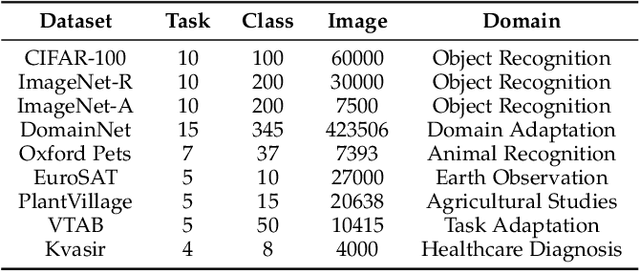
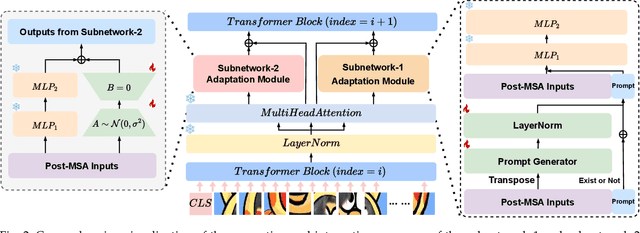

Abstract:Parameter-efficient fine-tuning for continual learning (PEFT-CL) has shown promise in adapting pre-trained models to sequential tasks while mitigating catastrophic forgetting problem. However, understanding the mechanisms that dictate continual performance in this paradigm remains elusive. To tackle this complexity, we undertake a rigorous analysis of PEFT-CL dynamics to derive relevant metrics for continual scenarios using Neural Tangent Kernel (NTK) theory. With the aid of NTK as a mathematical analysis tool, we recast the challenge of test-time forgetting into the quantifiable generalization gaps during training, identifying three key factors that influence these gaps and the performance of PEFT-CL: training sample size, task-level feature orthogonality, and regularization. To address these challenges, we introduce NTK-CL, a novel framework that eliminates task-specific parameter storage while adaptively generating task-relevant features. Aligning with theoretical guidance, NTK-CL triples the feature representation of each sample, theoretically and empirically reducing the magnitude of both task-interplay and task-specific generalization gaps. Grounded in NTK analysis, our approach imposes an adaptive exponential moving average mechanism and constraints on task-level feature orthogonality, maintaining intra-task NTK forms while attenuating inter-task NTK forms. Ultimately, by fine-tuning optimizable parameters with appropriate regularization, NTK-CL achieves state-of-the-art performance on established PEFT-CL benchmarks. This work provides a theoretical foundation for understanding and improving PEFT-CL models, offering insights into the interplay between feature representation, task orthogonality, and generalization, contributing to the development of more efficient continual learning systems.
 Add to Chrome
Add to Chrome Add to Firefox
Add to Firefox Add to Edge
Add to Edge